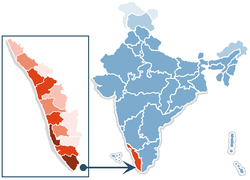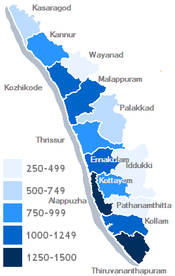Demographics of Kerala
From Wikipedia, the free encyclopedia
Location of Kerala in India

Kerala is a state in south-western India. Most of Kerala's 33.3 million people (in 2011) are of Malayali (Malayalam language speaking) ethnicity. Most of the Malayalam and English speaking Keralites derive their ancestry from Dravidian and Aryan communities that settled in Kerala and intermixed with each other and existing populations.
Additional ancestries derive from several centuries of contact with non-Indian lands, whereby people of Arab, Jewish, and other ethnicities settled in Kerala. Many of these immigrants intermarried with native Malayalam speakers.[2][3] A tiny number of Muslims thus take lineage from Arab settlers mixed with local population.Malayalam is Kerala's official language and is spoken by at least 96% of the people of Kerala; the next most common languages are Hindi and Tamil, spoken mainly by migrant workers from North and eastern parts of India and also from the neighbouring state of Tamil Nadu. Tulu and Kannada is spoken in most parts of the northern district of Kasaragod, adjoining Karnataka. In addition, Kerala is home to 321,000 indigenous tribal Adivasis (1.10% of the populace).[4] Some 63% of tribals reside in the eastern districts of Wayanad (where 35.82% are tribals), Palakkad (1.02%), and Idukki (15.66%).[5] These groups, including the Irulars, Kurumbars, and Mudugars,[6] speak their own native languages.[7][8][9] Cholanaikkan tribe in the Silent Valley National Park were contacted only in the 1970s and they are the most isolated tribe in the state.
Population
Population density of Kerala

Kerala's districts, shaded by population density.
Source: (GOK 2001).
Kerala is home to 2.76% of India's people, and - at 859 persons per km²;[10] its land is three times as densely settled as the rest of India. However, Kerala's population growth rate is far lower than the national average. Whereas Kerala's population more than doubled between 1951 and 1991 - adding 15.6 million people to reach a total of 29.1 million residents in 1991 - the population stood at 31.8 million by 2001 and 33.3 million in 2011.[10] Kerala's people are most densely settled in the coastal region, leaving the eastern hills and mountains comparatively sparsely populated.[11]
Hinduism is followed by the majority of Keralites (54.7%).Kerala is home to Hindu saints and swamis of all castes. Jagatguru Sree Adi Shankaracharya, Sree Narayana Guru, Sree Chattambi Swamikal and Vaikunda Swami were the first among the saints of Kerala. The major religions followed in Kerala are Hinduism (54.7% - Hinduism of Kerala), Islam (26.6%) and Christianity(18.4%).[12] Kerala also had a tiny Jewish population until recently, said to date from 587 BC when they fled the occupation of Jerusalem by Nebuchadnezzar.[13] The 2001 Indian census recorded only 51 Jews in Kerala. The synagogue in Kochi is the oldest in the Commonwealth of Nations. The state has many famous Temples, Mosques, and Churches. The oldest church in India is found in Kerala, believed to be established by St. Thomas the disciple of Jesus Christ.Features
Social development
Kerala ranks highest in India with respect to social development indices such as elimination of poverty, primary education and healthcare. This resulted from significant efforts begun in 1911 by the erstwhile Princely states of Cochin and Travancore to boost healthcare and education among the people and aided by the Christian missionaries. This central focus - unusual in India - was then maintained after Kerala's post-independence inauguration as a state.[14] Thus, Kerala has the highest literacy rate in India of 93.91% (2011);[15] and life expectancy is now the highest in India.There is a myth that suicide rates in Kerala are the highest in India, however statistics reveal otherwise[citation needed]. As per the 2011 census, Kerala and Puducherry are the only states in India with a female-to-male ratio higher than 0.99. The ratio for Kerala is 1.084 - 1084 females per 1000 males - while the national figure is 0.940.[10] It is also the only state in India to have sub-replacement fertility. UNICEF and the World Health Organization (WHO) designated Kerala the world's first "baby-friendly state" via its "Baby Friendly Hospital Initiative". The state is also known for Ayurveda, a traditional system of medicine - this traditional expertise is currently drawing increasing numbers of medical tourists. However, drawbacks to this situation includes the population's steady aging - indeed, 11.2% of Keralites are age 60 or over.[14]
Kerala's unusual socioeconomic and demographic situation was summarized by author and environmentalist Bill McKibben:[16]
Emigration
Kerala, a state in India, is a bizarre anomaly among developing nations, a place that offers real hope for the future of the Third World. Though not much larger than Maryland, Kerala has a population as big as California's and a per capita annual income of less than $300 mn dollar. But its infant mortality rate is very low, its literacy rate among the highest on Earth, and its birthrate below America's and falling faster. Kerala's residents live nearly as long as Americans or Europeans. Though mostly a land of paddy-covered plains, statistically Kerala stands out in social development; there's truly no place like it.
As of 2011, a total of 2,280,000 Keralites reside outside India. The majority of them are Muslims (45%), although Christians (37.5%) and Hindus (17.5%) are also significant in population. Largest populations are found in UAE (883,313) and USA (680,076).[17]
As of 2011, the major concentrations of expat Keralites are in the following nations:[18]
- UAE - 883,313
- United States - 680,076 (mainly U.S. Citizens)
- KSA - 574,739
- Oman - 195,300
- Qatar - 148,427
- Kuwait - 127,782
- Bahrain - 101,556
- United Kingdom - 44,640
There are more than 1,000,000 migrants living in Kerala,[19] mostly from Assam and West Bengal, constituting more than 8% of the population. There are also migrants from Bihar, Jharkhand, Chhattisgarh, Orissa, and the North East.[20] In some places like Perumbavoor they outnumber the locals.[21] Some alarmist have even wrote that "of late, Kerala has been hearing more Bengali than its own local language",[22] which is a huge exaggeration, since there are very few migrants in Northern and Southern Kerala. Most of the migrants tend to concentrate around central Kerala, especially in Kochi (Notable exceptions would be Thiruvananthapuram and Kozhikode. In Kozhikode, northern immigrants constitute more than 8% of the total population, at 35,000).[19]
Studies indicate that by the time of 2016 state elections, migrants will become a crucial voting block in many of the constituencies in Thiruvananthapuram, Kochi, Kozhikode, Thrissur and Kannur.[23]
Most populous urban agglomerations
The following is a list of most populous urban agglomerations in the Kerala state of India. Population statistics indicated in this article as of 2001 census.[24][25][26][27]Note that this is a list of metropolitan population and does not indicate the city populations. For that, see List of most populous cities in India.
Rank
UA
Population (2011)
Population (2001)
District
1
Kochi
2,117,990
1,355,972
Ernakulam
2
Calicut
2,030,519
1,015,681
Kozhikode
3
Thrissur
1,854,783
1030,122
Thrissur
4
Trivandrum
1,679,754
889,635
Trivandrum
5
Malappuram
1,698,645
170,409
Malappuram
6
Kannur
1,642,892
498,207
Kannur
7
Kollam
1,110,005
380,091
Kollam
8
Attingal
1,019,395
180,944
Trivandrum
9
Cherthala
455,408
141,558
Alappuzha
10
Kayamkulam
427,091
68,585
Alappuzha
11
Kottayam
357,533
172,878
Kottayam
12
Palakkad
293,566
283,369
Palakkad
13
Alappuzha
241,072
282,675
Alappuzha
14
Ottappalam
238,238
49,242
Palakkad
15
Kanhangad
229,706
129,367
Kasaragod
16
Kasaragod
192,761
75,968
Kasaragod
17
Changanassery
127,971
51,967
Kottayam
18
Chalakkudy
114,901
48,380
Thrissur
19
Kothamangalam
114,574
37,173
Ernakulam
Class I cities
Kerala has seven million-plus cities: Kochi, Kozhikode, Thrissur, Malappuram, Thiruvananthapuram, Kannur and Kollam. Over a third of Keralites live in these large cities (a higher percentage than any other state), and over half the population lives in urban centres.[28]
[hide]List of major cities in Kerala
No.
City
District
Population

Thiruvananthapuram

Kochi

Kozhikode

Kollam

Thrissur
1
Thiruvananthapuram
Thiruvananthapuram
752,490
2
Kochi
Ernakulam
601,574
3
Kozhikode
Kozhikode
432,097
4
Kollam
Kollam
349,033
5
Thrissur
Thrissur
315,596
6
Alappuzha
Alappuzha
174,164
7
Palakkad
Palakkad
131019
Source: 2011 Census of India
According to World Gazetteer population calculation for the year 2010, five of the top 100 most populous metropolitan areas in India belong to Kerala. They are Kochi, Thiruvananthapuram, Kozhikode, Kannur and Kollam ranking 26, 43, 46, 73 and 86 respectively.
Ethnic groups
Main article: Ethnic groups in Kerala
The great majority of residents of Kerala are Malayalis, but there are many smaller ethnic groups including Tuluvas, Tamils, Kannadigas and Konkanis. In addition, as of early 2013 there are close to 2.5 million (7.5% of state population) migrant workers from other states of India in Kerala.[31]Religion/caste communities
Castes of Kerala
Caste
Population (%)
Ezhavars (SNDP) (Religion:Hindu)
23%
Nairs (NSS) (Religion:Hindu)
14%
Dheevars (Religion:Hindu)
3%
SCs(Dalits) (Religion:Hindu)
9.8%
Adivasis(STs) (Religion:Hindu)
1.14%
Brahmins (Religion:Hindu)
1%
Muslims
26.56%
Christians
18.38%
Others Backword Castes (Religion:Hindu)
3%
The Scheduled Caste (SC) population of Kerala State is 3,123,941 which is 9.8% of overall population. Scheduled Tribes in Kerala with a population of 3.64 lakh constitute 1.14% of the population of state. Denominations groups among Christians [37]
Catholic church (Syrian and Latin rites) is the largest denomination among Kerala Christians. Malankara orthodox church, Jacobite Syrian orthodox church and Marthomite Syrian church denominations claim Syrian roots. Major Protestant groups are: Church of South India(C.S.I.) and various Pentecostal churches are major Protestant churches.Chaldean, Seventh Day Adventists, Salvation army etc. are some of the other denominations. Denominations should not be considered as caste or ethnic groups. Caste groups among Christians, which is a continuation of casteism in Hinduism, runs parallel to denominational divisions. One caste group may be spread over many denominations. One denomination may have more than one caste group in it. Person belonging to a denomination can convert to another denomination. Hence definitely these are not ethnic divisions.[38]
Muslims - 26.6% (2011 census).